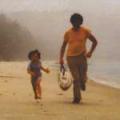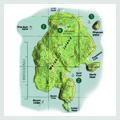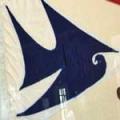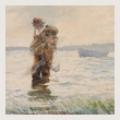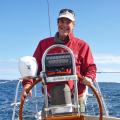Willis Beal: April and Kristi
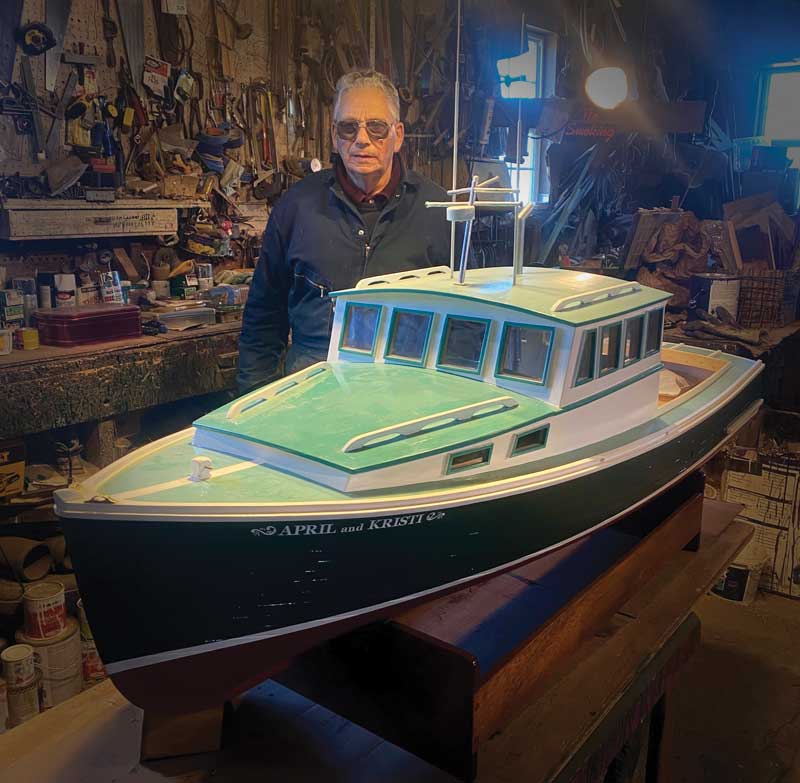 Willis Beal stands behind his recently “launched” model, April and Kristi. Photo by Art Paine
Willis Beal stands behind his recently “launched” model, April and Kristi. Photo by Art Paine
Beals Island, way downeast, has long been known for its classic wooden lobsterboats. But the latest launch by Willis Beal, one of the island’s noted builders, will not be used for hauling traps in Moosebec Reach off Jonesport. That’s because it’s a 5-foot-long “little boat,” meant for display.
Beal, who has built more than two dozen full-size boats during his career, began building models as a child. His most recent project is the April and Kristi—an exact replica of the biggest full-sized boat that he ever built. The model was commissioned by Alonzo Alley, a local lobsterman, and model boat collector.
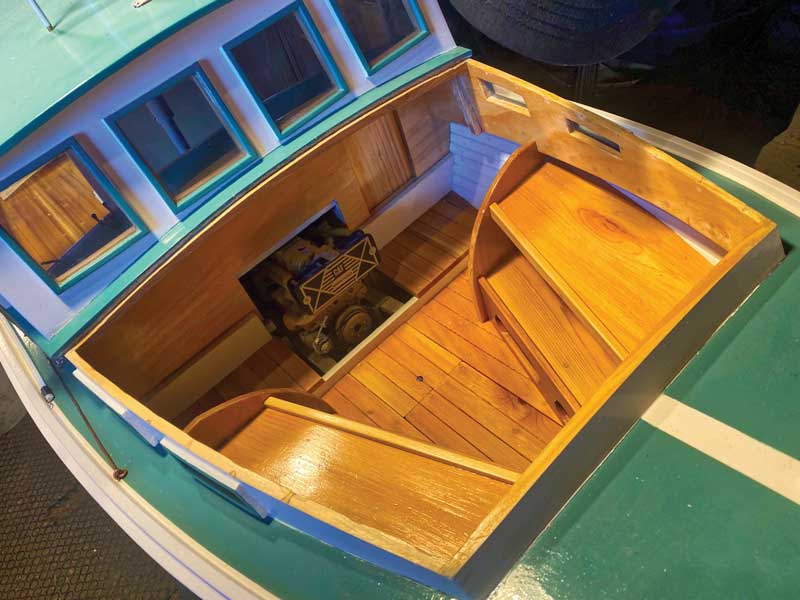 Lift the removable front cabintop, and a Cat engine is revealed. Don’t forget to check the oil. Photo by Art Paine
Lift the removable front cabintop, and a Cat engine is revealed. Don’t forget to check the oil. Photo by Art Paine
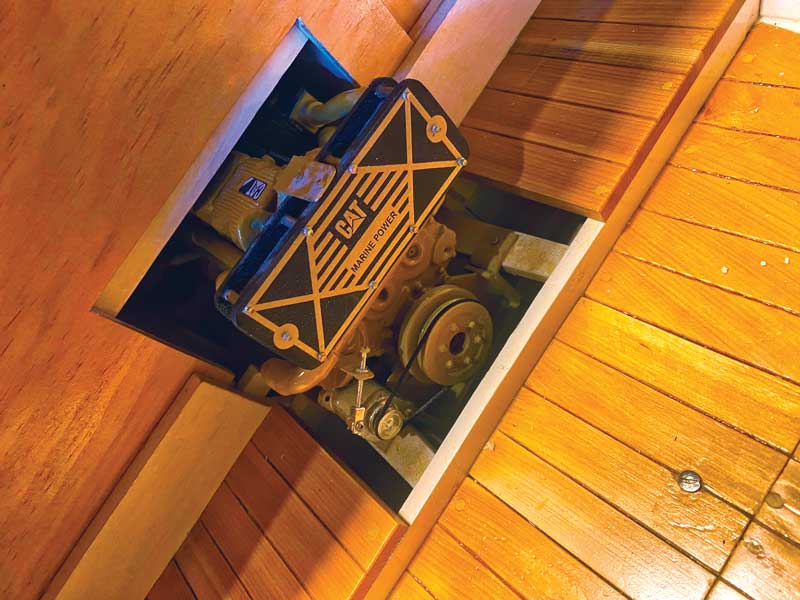 Photo by Art Paine
Photo by Art Paine
One of the last builders of wooden lobsterboats on Beals Island, Willis Beal is justly famous for his beautiful and handy vessels. Probably the most famous was Silver Dollar. Ever-present at the
lobsterboat races, and featuring the quintessential “Jonesporter” skeg-built style, Silver Dollar’s lines are preserved in the National Archives. Beal stopped building full-size boats in 1992, when demand for wooden boats waned, but this didn’t slow him down much. His love for model boats—what he calls
“little boats”—had always simmered in him. Beal had seen lots of half-models as a youngster, but he particularly loved full models—the ones that show a whole boat. These days he fishes for lobsters
in the warmer season and builds boat models through the winter.
Things downeast can be reminiscent of bygone times, so it took some effort to arrange an interview with Beal. He does not own either a cell phone or a computer, and often is off fishing during the day. Desperate to meet my deadline, I called my friend Doug Dodge who agreed to drive to Beal’s house. There he found Beal’s wife, Genesta, who reminded him that Beal goes out lobstering most days. Hauling alone he sets 350 single traps, and is famous for spending an hour at day’s end washing his boat down like a yacht. Later he told me, “If anything happened to me and they found me cold, I wouldn’t want anyone thinking I was a slob.”
But this day he returned home early and when I heard that, I jumped in my car and headed downeast. When I arrived, Beal took me up to a bedroom that serves as a museum of family artifacts, most of which are boat models. He recounted his nautical life through the story of the models, half of which he built, while the others were gifts from friends.
 Willis Beal planks from the keel upwards. He only builds hulls upside down on models. Photo by Alonzo Alley
Willis Beal planks from the keel upwards. He only builds hulls upside down on models. Photo by Alonzo Alley
Beal loved boats from the time he was young. He hung around the eight boatshops within bicycling distance and skipped school once to watch a Harold Gower launching; Gower (1899-1972) is considered by many to be one of Beals’s finest builders. Through observation, Beal learned how to put a boat together, and never tired of hearing fishermen debate the merits of different builders. Eventually he built 26 full-size boats, all but four of them for lobstering.
Willis is a generous, devout, articulate man—and a true craftsman. At one point he picked up a model he had designed and built at the age of 17, when he was a junior in high school. It was his take on a 38-foot lobsteryacht for rusticators, and he is justifiably proud of this early effort. Since he and I are the same age (79), we figured that he made this model in 1961, at a time when lobsterboats were long and narrow. But this model was for a 14-foot wide boat—the generous beam putting Beal about 20 years ahead of his time. A boat built from these lines would be great even today, with a gas or diesel engine, and a hull of either wood or glass. He didn’t use a personal computer on this project—they didn’t yet exist. Nor did he do paper calculations; he simply used his eye.
When the time came for him to build his first working boat, around age 20, he took the lines off this lobsteryacht model and another model he built to play with, blending the two hull shapes to come up with a 26 footer for his younger brother to take fishing. Beal built his next full-size boat for himself. When he started working his third boat, this one commissioned by a paying customer, other local boatbuilders took notice—Harold Gower offered to lend him his molds.
Beal’s model building was inspired in part by Alvin Beal, a distant cousin, who launched workboats into Moosabec Reach for years, and afterward “retired” into building models. When Willis Beal was about 35, he bought one of Alvin Beal’s models, a torpedo stern boat, which he still treasures.
 Like the full-sized fishing boat, the April and Kristi model is beautiful from every angle. Photo by Art Paine
Like the full-sized fishing boat, the April and Kristi model is beautiful from every angle. Photo by Art Paine
Willis Beal’s models, including the April and Kristi, are built using all the same techniques as his full-size boats, just on a smaller scale. He steams solid (not split) ribs in an electric fry pan he “borrows” from Genesta, bends them over a jig, and makes all other parts of the boat in scale to the original scantlings. He always planked his full-size boats starting down at the keel rabbet and going upward, just the way his mentor Freddy Lenfesty taught him; and he does the same with his models.
In this model he decided to make the front cabintop removable so you could peek inside. He made sure that the pine ceiling looked right. At one point Alonzo Alley came along with a perfect little replica of the Cat engine, painted Cat Yellow. The engine was made by Donald Wescott, from Southern Maine. Beal built a tiny door in front of it so you can check the oil.
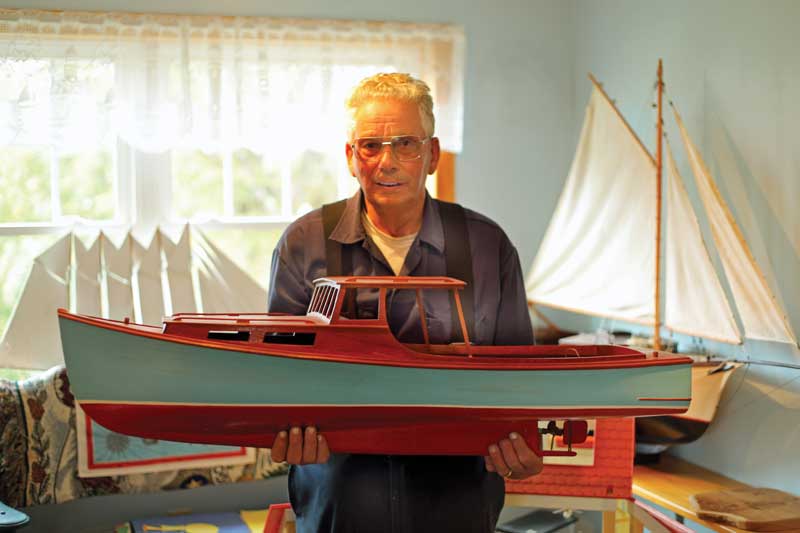 Willis is justifiably proud of the “lobsteryacht” model he designed and built at age 17. Photo by Art Paine
Willis is justifiably proud of the “lobsteryacht” model he designed and built at age 17. Photo by Art Paine
The model also features a removable lift-out over the shaft and stuffing box back in the cockpit. Beal made certain that the paint colors perfectly matched those on the original boat, and for the first time on this model he painstakingly scribed all the individual topside planks onto the hull.
The April and Kristi was the last, biggest, and most rugged working lobsterboat that Willis Beal had built in his shop. The boat was constructed super strong for gillnetting and year-round offshore lobster fishing for William Smith of West Jonesport. She was just over 42 feet long, with a 6" wide oak keel, 1 ½ by 2 ½" solid oak timbers, and 1 ½" cedar planking. Even the floors (“sharp risers” in Beal’s parlance) were two full inches thick and he installed twice as many as usual.
Luckily, when Alonzo commissioned the replica of April and Kristi, the boat was hauled out on Wass Island for a new engine. Willis Beal went over there and took off the lines for the model.
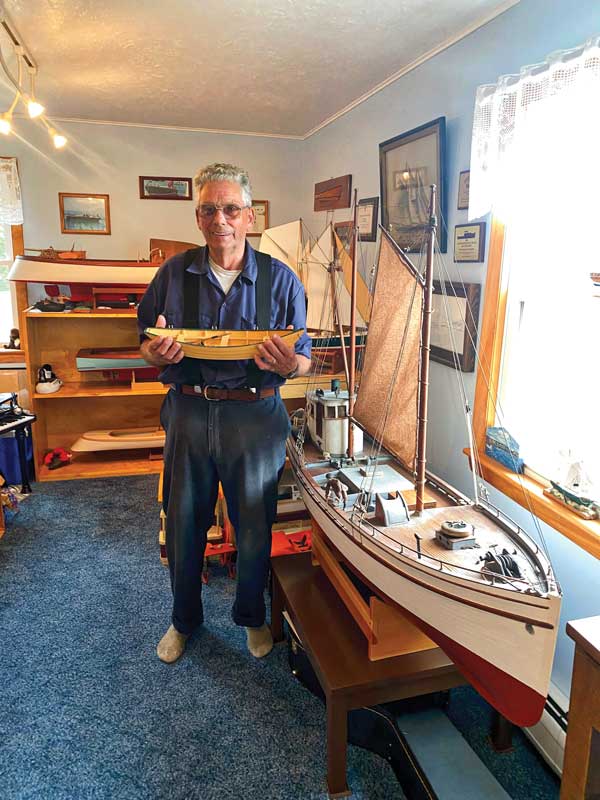 Willis and his wife Genesta use a spare bedroom as a bit of a family and boat model museum. Alonzo Alley gave Willis the sardine carrier model that is at his side. Photo by Art Paine
Willis and his wife Genesta use a spare bedroom as a bit of a family and boat model museum. Alonzo Alley gave Willis the sardine carrier model that is at his side. Photo by Art Paine
Making these models in miniature takes about as long as building the original boats, Beal said. This one was the only one of his models that took him over two winters to build. He keeps track of his time and estimates that he earns about $1.25 an hour for the work. None of his models has gone into permanent museum collections, and only one has been sold to a person living more than a few miles from Moosabec Reach.
Willis Beal isn’t likely to get rich from building his model boats, but having gotten to know him, I contend that his perception of “riches” is about things more valuable than money.
✮
Contributing Author Art Paine is a boat designer, artist, and writer who lives in Bernard, Maine.
APRIL & KRISTI Specifications
LOA: 61.5"
LWL: 61"
Beam: 23"
Draft: 4.5"
Displ.: 78 lbs.
Designer/Builder:
Willis Beal
Related Articles
Share this article:
2023 Maine Boat & Home Show

Join Us for the Maine Boat & Home Show!
Art, Artisans, Food, Fun & Boats, Boats, Boats
August 11 - 13, 2023 | On the waterfront, Rockland, Maine
Click here to pre-order your tickets.
Show is produced by Maine Boats, Homes & Harbors magazine.










